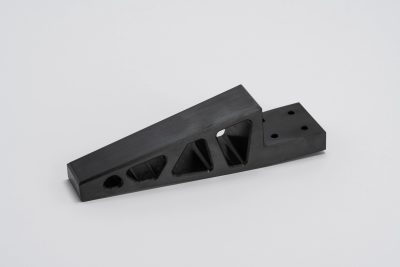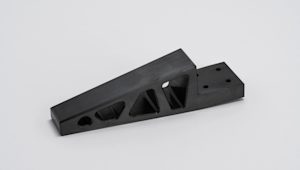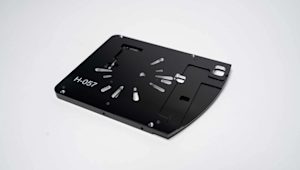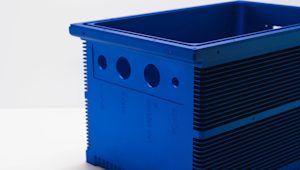What is media blasting and how does it work?
Want to learn about media blasting? Here’s a guide to using the post-processing technique, how it works, its common industrial uses, and more.
Read articleYou’ve come to the right place. Hubs is now Protolabs Network.
The same broad capabilities, exceptional quality and competitive pricing under a new brand.






EN
Want to learn more about black oxide coating? In this article, we’ll take a look at black oxide as a surface finish, its history, common applications, and more

Black oxide is a conversion coating used on iron, zinc, steel, stainless steel, and copper. It results in a black, smooth surface finish, and improves corrosion resistance and wear resistance. Black oxide is commonly used as a surface finish in a variety of industrial and commercial applications, including automotive and aerospace components, machinery and tools.
The exact origin or inventor of black oxide coating is not well documented, but the process of blackening iron and steel has been used for centuries by blacksmiths and metalworkers. It was – and is – seen as a full or partial solution to several challenges.
Preventing corrosion. Black oxide coating helps improve metal components’ resistance to corrosion and rust, extending their lifespans and reducing the need for expensive or time-consuming repairs or replacements.
Reduced wear. Black oxide enhances the hardness and durability of metal surfaces, reducing wear and tear and improving the performance of metal components in hard-working or industrial environments.
Aesthetics. With a smooth, matte finish, black oxide improves the appearance of metal components, making them easier to incorporate into a variety of applications, as their visibility is not an issue.
Reduced light reflection. For a variety of functional and cosmetic applications, a black oxide coating makes surfaces less reflective.
Black oxide is still used to achieve the above results, and is well-suited for applications that require a durable, low-maintenance, and corrosion-resistant surface finish, such as:
Fasteners, hardware, and tools. Black oxide is a popular finish for fasteners such as screws, nuts, bolts, as well as hand tools and other hardware, as it provides a matte, aesthetically pleasing finish that is corrosion-resistant, durable, and easy to grip.
Automotive and aerospace components. In the automotive and aerospace industries, black oxide is used as a surface finish for a variety of parts, including engine components, suspension systems, and landing gear.
Industrial equipment. Black oxide is used to finish a wide range of industrial equipment, such as pumps, valves, and machinery, to provide corrosion- and wear-resistant surfaces.
Black oxide is a finishing process that involves immersing a part in a solution including sodium hydroxide and potassium nitrate. At Protolabs Network, applying black oxide is a six-step process, in which a part is:
Run through machining and deburring
Cleaned using alkaline solutions
Rinsed in water
Black-oxidized via immersion in a hot (135-145ºC) alkaline bath for a period of five to 40 minutes, depending on the size of the part
Rinsed in water once again
Given an after-finish treatment with oil, lacquer, or wax to seal the oxide surface
Black oxide differs from other popular surface finishes in several ways.
Aesthetics. While other metal finishes, such as anodizing, electroplating, and powder coating, offer a variety of color options, black oxide provides a unique, matte black finish.
Durability. Black oxide provides a durable, corrosion-resistant surface that is often more wear-resistant than other finishes.
Process. Creating a black oxide finish is relatively simple and cost-effective compared to other finishes, such as electroplating or anodizing.
Consider these important factors when using black oxide coating.
Coat thickness. The thickness of black oxide coating depends on several factors, including the type of metal being coated, the method used to produce the black oxide coating, and the desired level of protection, with thicker coatings providing increased protection. Typically, however, black oxide coatings are between 0.0002 to 0.0006 inches thick.
Use on stainless steel. It is possible to use black oxide coating on stainless steel. While stainless steel is naturally rust and corrosion resistant, a black oxide coating can provide additional protection as well as enhance its aesthetic qualities.
Follow these tips and note some design limitations for black oxide coatings.
Complex geometries. Parts with complex geometries and tight corners may not be suitable for black oxide coating, as it can be difficult to achieve a uniform coating on these surfaces.
Surface finish. Black oxide coating works best on surfaces with a smooth, uniform finish, as rougher surfaces can result in a less uniform coating.
Material compatibility. Not all metals are compatible with black oxide coating. Some metals, such as aluminum, do not react well with the black oxide process, which can result in a poor-quality finish.
Corrosion resistance. While black oxide provides some protection against corrosion, it is not as effective as other finishes such as anodizing or electroplating.
Masking. Black oxide does not have a significant dimensional impact, therefore masking parts is not necessary.
To produce a part with a black oxide coating, upload a CAD file for an instant quote and automatic DFM analysis. You can also read more about our black oxide service, as well as other optional surface finishes for your parts.
For further information or recommendations on finishes or materials with the right properties for your project, contact networksales@protolabs.com.

Black oxide provides parts with improved corrosion resistance, wear resistance, durability, and aesthetics.
Black oxide is not as corrosion-resistant as other surface finishes, and can be difficult to repair if damaged.
Black oxide is used in the automotive, aerospace, and manufacturing industries for a wide variety of commercial and industrial applications.
Black oxide improves the corrosion and wear resistance of metal parts, as well as their aesthetic qualities.
Applying black oxide is a relatively simple process, meaning it is often more affordable than other surface finishes. To cut costs further, consider batch production or thinner overall coatings.
Black oxide coating is commonly used on automotive and aerospace parts, tools, fasteners, industrial equipment, and firearm components.

Want to learn about media blasting? Here’s a guide to using the post-processing technique, how it works, its common industrial uses, and more.
Read article
Find out about the range of surface finishes and materials that make for aesthetically pleasing custom parts.
Read article
Passivation is a chemical process used to enhance the corrosion resistance and durability of a metal. Find out how it works and when it’s a worthwhile addition to your custom parts.
Read article
Learn about the differences between Type II and Type III anodizing, their benefits, typical applications, and how to choose the ideal surface finish for your part.
Read article
Want to learn more about black oxide coating? In this article, we’ll take a look at black oxide as a surface finish, its history, common applications, and more
Read article
How do you add logos, lettering, serial numbers and other customized designs to your custom parts? Part marking is a cost-effective way to give parts those extra identifying and/or cosmetic details. Learn the common part marking techniques on the market today, including laser engraving and silk screening.
Read article
What is powder coating and in what cases should you select it as a finish for CNC-machined metal parts? This article covers the details of the powder coating process, as well as when to choose it for the best performance and quality.
Read article
What is anodizing? Anodizing is key to finishing parts made from aluminum and other metals. Learn how anodizing works and why it is an important part of CNC machining and manufacturing.
Read article
What surface finishes are available for CNC machining? You can apply post-processing and surface finishes to improve the surface roughness, cosmetic properties and wear resistance of metal parts. Learn about the most common ways to finish CNC machined parts, and how to select the best methods for your applications.
Read article
A comprehensive guide describing the range of post-processing options for FDM printed parts
Read article
What are the post-processing methods and steps for SLS and MJF 3D printing? In this article, we explore the most common post-processing methods, including dyeing and metal plating.
Read article
A comprehensive guide describing the range of post-processing options for SLA printed parts
Read article
Want to learn about media blasting? Here’s a guide to using the post-processing technique, how it works, its common industrial uses, and more.
Read article
Find out about the range of surface finishes and materials that make for aesthetically pleasing custom parts.
Read article
Passivation is a chemical process used to enhance the corrosion resistance and durability of a metal. Find out how it works and when it’s a worthwhile addition to your custom parts.
Read article
Learn about the differences between Type II and Type III anodizing, their benefits, typical applications, and how to choose the ideal surface finish for your part.
Read article
Want to learn more about black oxide coating? In this article, we’ll take a look at black oxide as a surface finish, its history, common applications, and more
Read article
How do you add logos, lettering, serial numbers and other customized designs to your custom parts? Part marking is a cost-effective way to give parts those extra identifying and/or cosmetic details. Learn the common part marking techniques on the market today, including laser engraving and silk screening.
Read article
What is powder coating and in what cases should you select it as a finish for CNC-machined metal parts? This article covers the details of the powder coating process, as well as when to choose it for the best performance and quality.
Read article
What is anodizing? Anodizing is key to finishing parts made from aluminum and other metals. Learn how anodizing works and why it is an important part of CNC machining and manufacturing.
Read article
What surface finishes are available for CNC machining? You can apply post-processing and surface finishes to improve the surface roughness, cosmetic properties and wear resistance of metal parts. Learn about the most common ways to finish CNC machined parts, and how to select the best methods for your applications.
Read article
A comprehensive guide describing the range of post-processing options for FDM printed parts
Read article
What are the post-processing methods and steps for SLS and MJF 3D printing? In this article, we explore the most common post-processing methods, including dyeing and metal plating.
Read article
A comprehensive guide describing the range of post-processing options for SLA printed parts
Read articleShow more
Show less